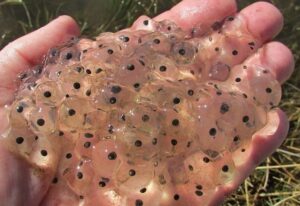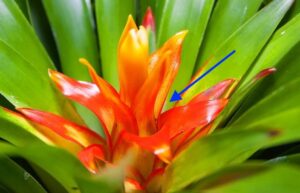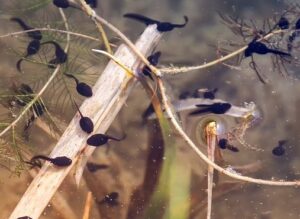It’s quite intriguing when you learn about the poison dart frog life cycle. When it comes to the amphibian world, hearing about the poison dart frog is pretty common.
After all, poison dart frogs are pretty common when it comes to having them as pets.
Growing up, you’d probably have a general idea of a frog’s life cycle. You learn them in school, you see them in cartoons, etc.
Before I go fully in-depth on the poison dart frog life cycle, here’s a general idea of the 5 phases:
- Phase 1: They start off as eggs
- Phase 2: The eggs become fertilized
- Phase 3: These eggs will then hatch into tadpoles
- Phase 4: Tadpoles will grow into adulthood
- Phase 5: Adult poison dart frogs will begin to mate
In this article, you’ll learn about the life cycle and phases of these frogs. To navigate to a specific poison dart frog topic, feel free to use the table of content below.
VivariumTips.com is a participant in the Amazon Services LLC Associates Program, an affiliate advertising program designed to provide a means for us to earn fees by linking to Amazon.com and affiliated sites.
When it comes to the poison dart frog life cycle, their life is quite unique. Let’s jump right into the first phase!
Phase 1: Starting Off As An Egg

Before they are frogs, they start off as eggs. Female adult poison dart frogs will find a moist/wet area to lay their eggs where it’s usually safe.
I published an article on VivariumTips explaining in-depth on where poison dart frogs generally lay eggs. Feel free to check it out!
To give you a general idea, they find these areas to lay their eggs:
- on the base of a leaf
- on the crook of a branch
- in a hole in a tree
- in a burrow in the soil
Once the female poison dart frog lays her eggs, you will notice that the eggs will have a jelly-like sac covering them.
Of course, this occurs right after the female dart frogs find a male dart frog to mate with.
Now that the eggs are laid, this event will lead to phase 2.
Phase 2: Fertilization Of The Eggs
After the eggs are laid in a safe location, the male poison dart frog has to fertilize them. Fertilization occurs outside of the female poison dart frog’s body just in case you didn’t know.
The female dart frog doesn’t have to be present during this phase, only the male.
Once these eggs are fertilized by the male dart frog, the eggs are then protected by the frog that fertilizes it.
Poison dart frogs are quite unique when comparing them to other amphibian species because they’ll guard the eggs while other species will fertilize the eggs and move on.
After the fertilization stage, we move on to phase 3.
Phase 3: Hatching Into Tadpoles
After giving it some time, the eggs will then hatch into tadpoles. During this phase, the mother dart frog is usually present when the tadpoles are out of their eggs.
These tadpoles will find their way onto the mother dart frog’s back while she explores for locations where these tadpoles can safely stay.
The locations that the mother dart frog finds are generally areas where these tadpoles can grow safely into adulthood.

Location Example:
The mother dart frog usually find plants like a bromeliad to keep her baby tadpoles between the leaves. If you take a close look at the image above, the blue arrow points where the bromeliad collects water from the rain. This makes the perfect and safe spot for the mother poison dart frog’s tadpoles.
During the time these tadpoles spend in the water of the bromeliad, they will feed on mosquito larvae and other consumable stuff like algae.
Sometimes, the mother poison dart frog will provide her tadpoles with unfertilized eggs to prevent her tadpoles from starving. Over time, these tadpoles will grow into young frogs which leads to phase 4.
Phase 4: Tadpoles Grow Into Juveniles

Once these tadpoles lost their tails and grow into young juvenile frogs, they’re ready to begin their life into adulthood. To give you an idea of the time it takes to go from phase 1 to phase 4, it usually takes approximately one year.
During this phase, they will adapt and grow into adulthood. Once they’re fully ready, phase 5 begins.
Phase 5: Waiting Until The Mating Season

For poison dart frogs, the mating season is usually the rainy season. There are two things that you should keep in mind when it comes to poison dart frogs mating.
- They wait until the rainy season
- When the temperature is warm enough
During the mating season, male poison dart frogs will likely fight other males to keep their territory. After all, there are territorial creatures.
Once the male dart frog’s territory is established, the frog will create a trill to attract the female poison dart frogs.
The breeding begins only if the female frog is interested in the male frog.
If the female dart frog is interested, then the breeding begins. After all of this happens, the female will find a location to lay her eggs which takes us back to phase 1 to repeat the cycle.
From VivariumTips,
Hopefully, this guide helped you learn about the poison dart frog life cycle. As you can see, poison dart frogs are quite unique when comparing to other amphibian species.
I find it interesting that the male poison dart frog will stay and protect the eggs while the mother waits until they hatch and carries the tadpoles to a much safer area.
If you enjoyed reading “5 Phases Of The Poison Dart Frog Life Cycle,” you might also like other dart frog-related articles:
- Are Dart Frogs Endangered?
- Are Dart Frogs Good Pets?
- Can You Die If You Touch A Poison Dart Frog?
- How To Heat Dart Frog Vivariums?
- Do Dart Frogs Smell?
- How Many Dart Frogs Can You Keep Together?
- Can Dart Frogs Live Alone?
- Can Dart Frogs Swim?
You can support VivariumTips by sharing this article with another poison dart frog enthusiast!
If you have any questions about the poison dart frog life cycle, feel free to comment below and I’ll get back to you as soon as possible. 🙂

